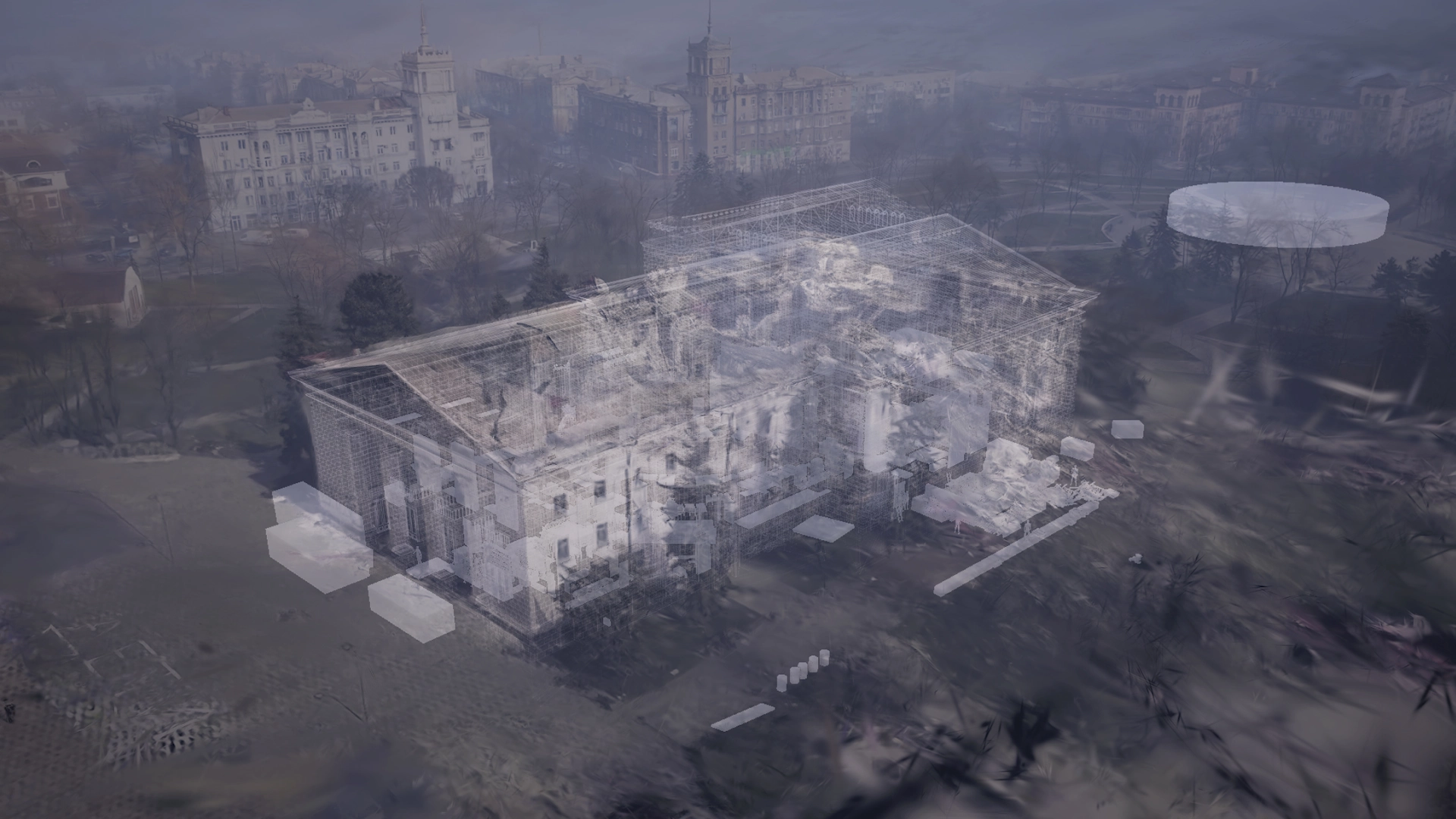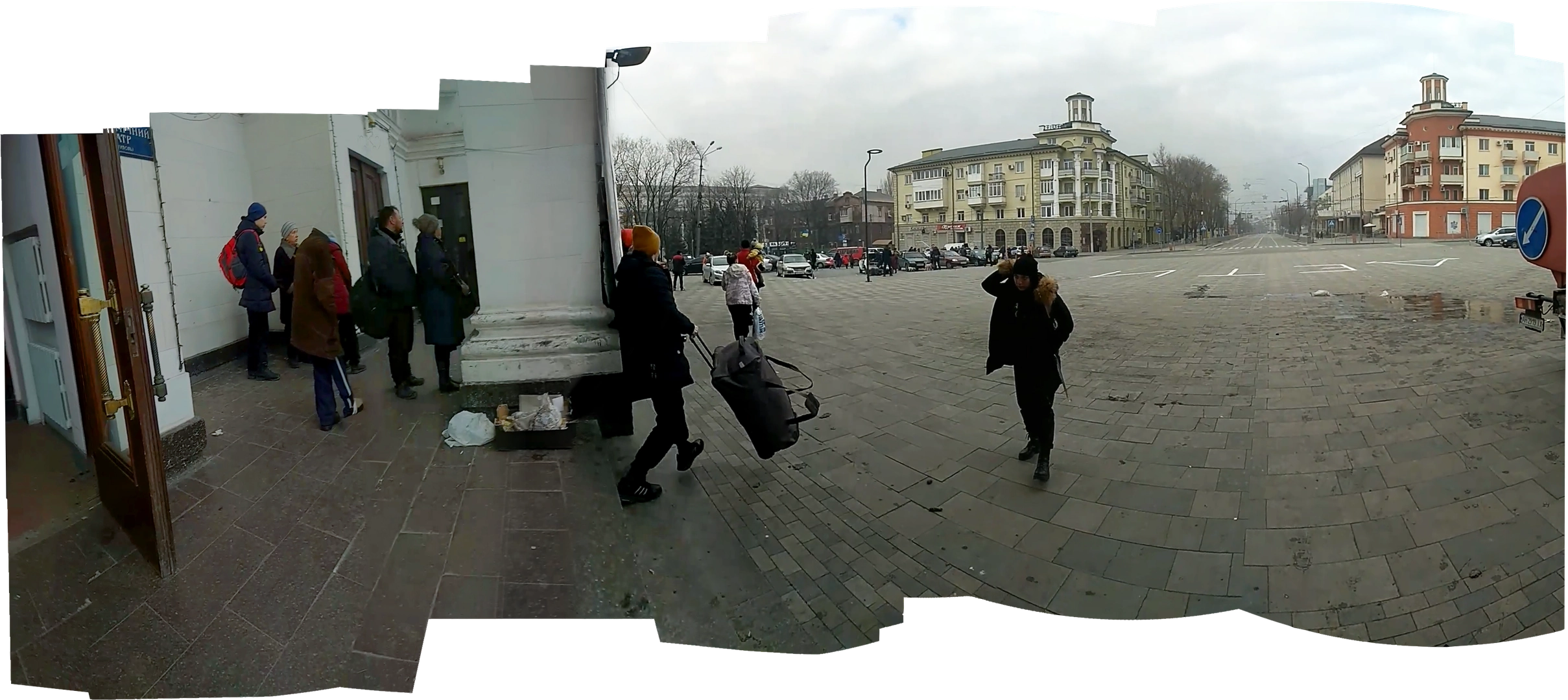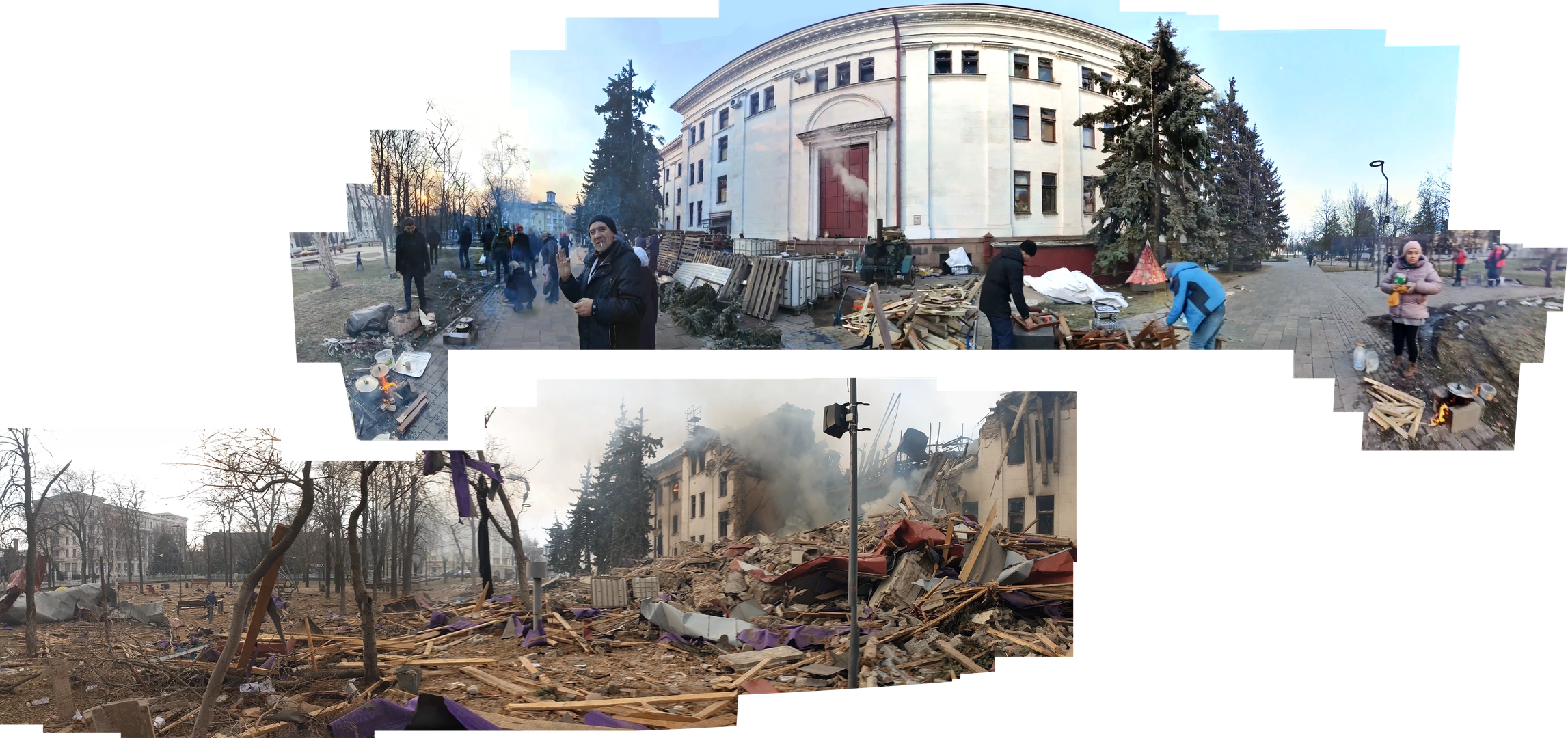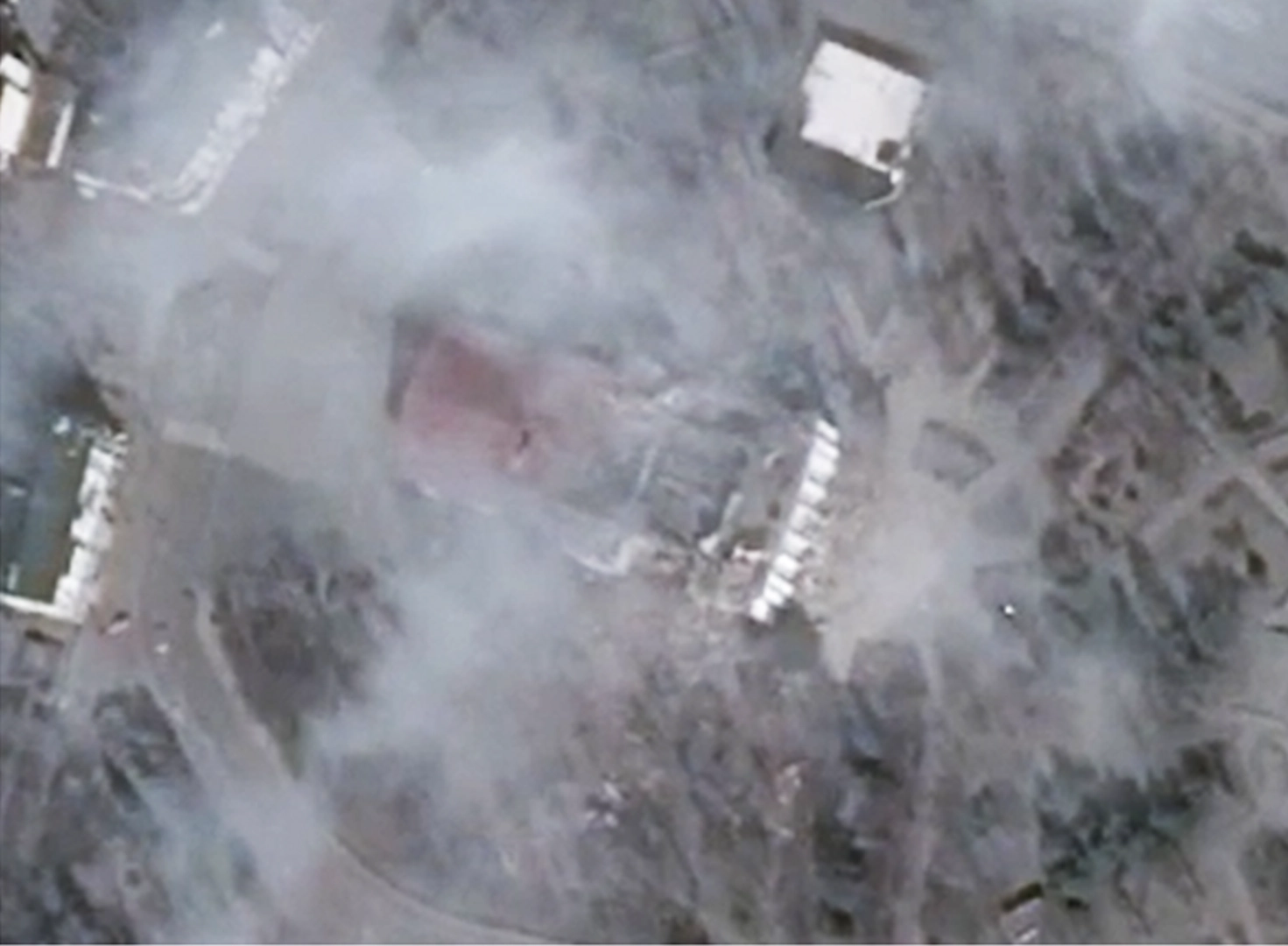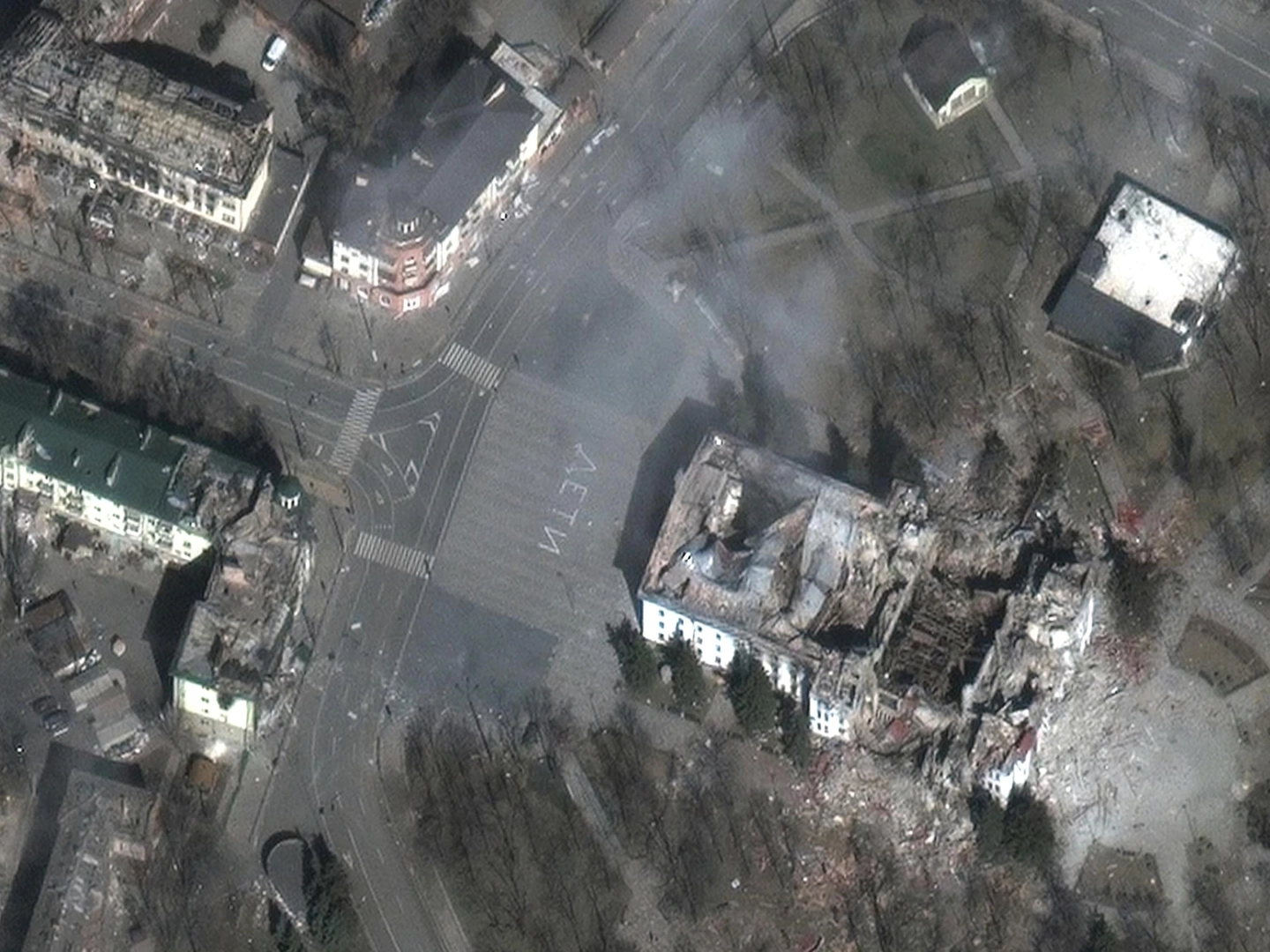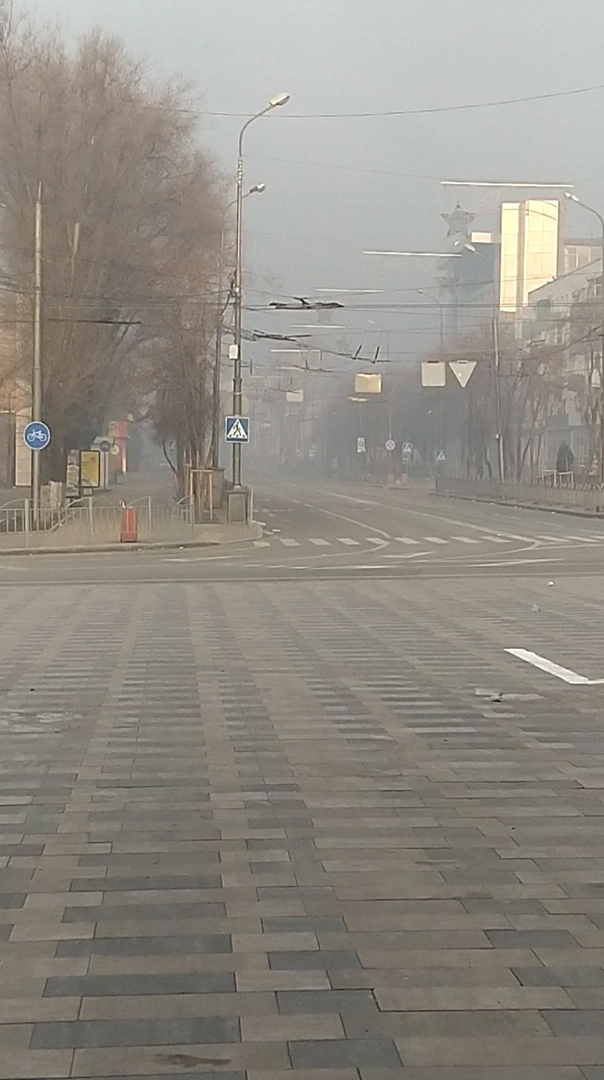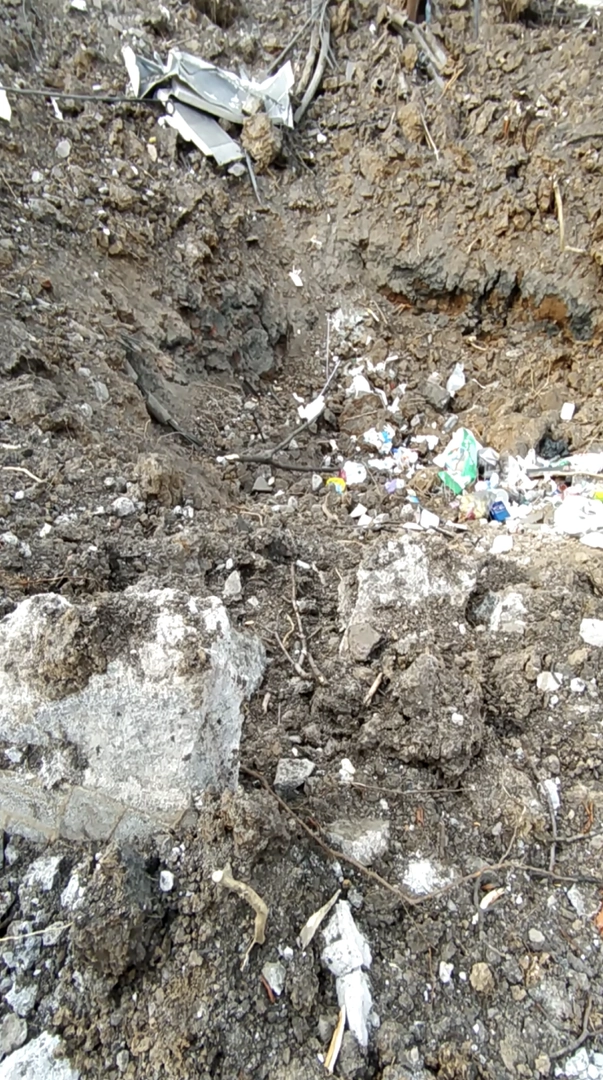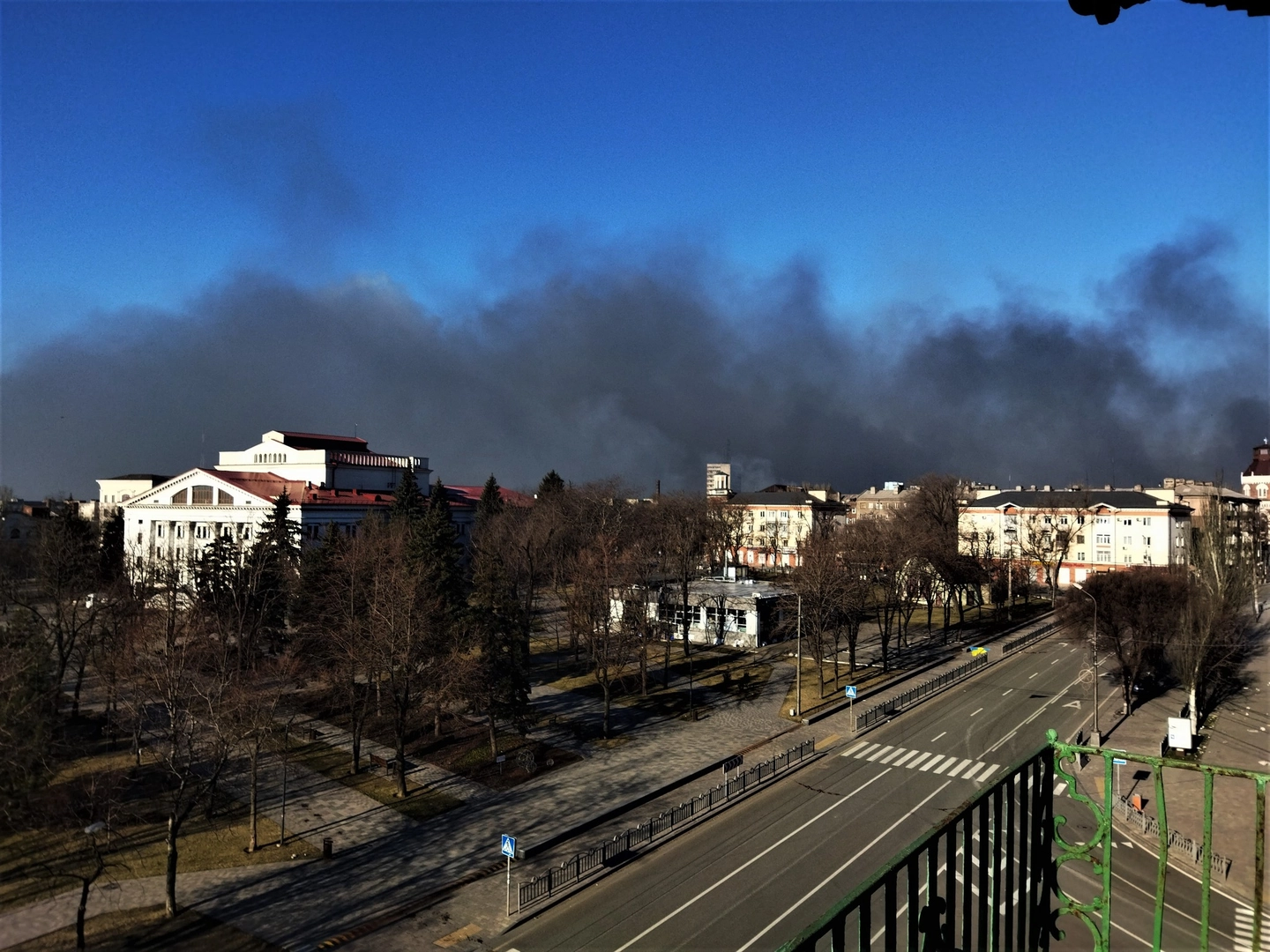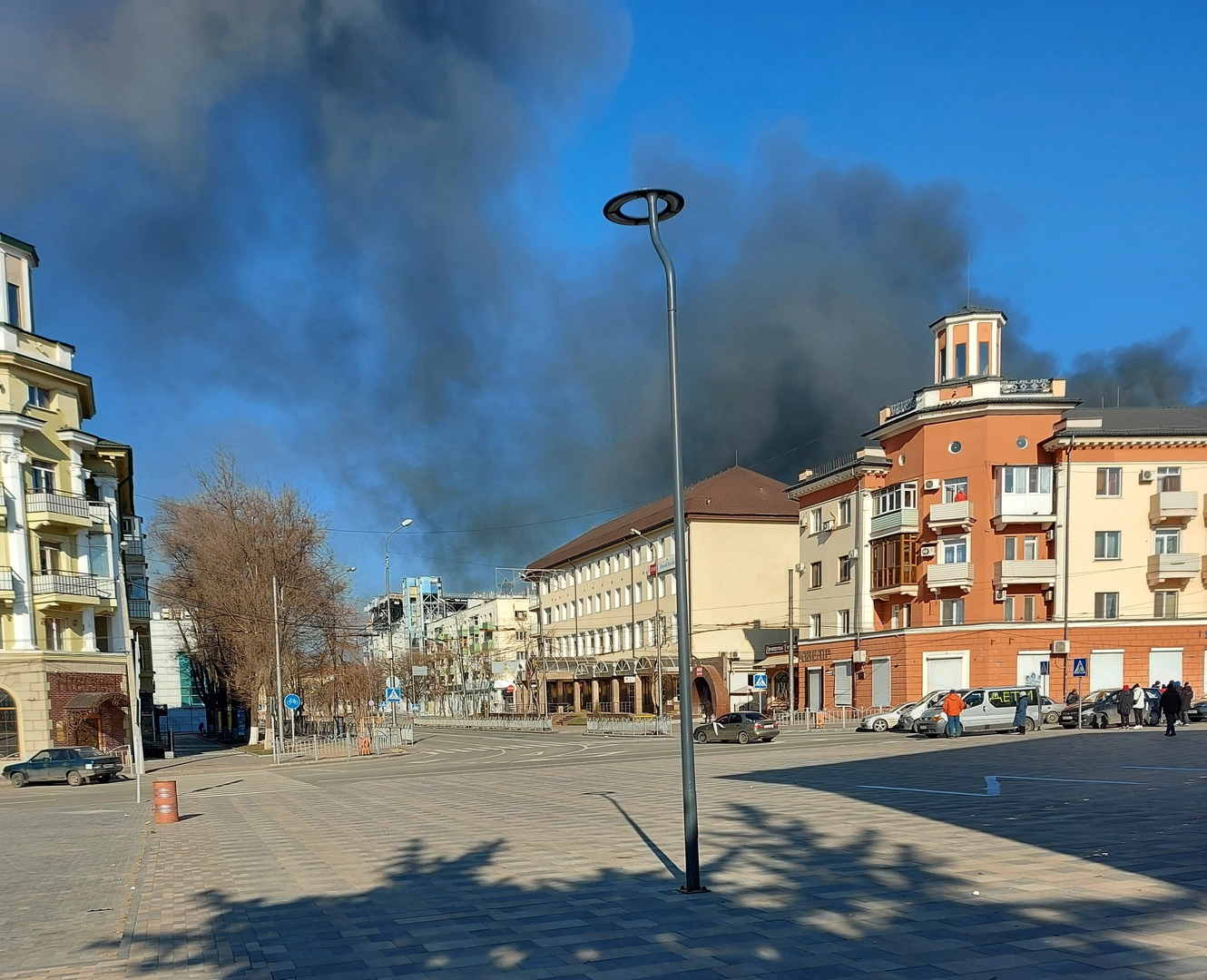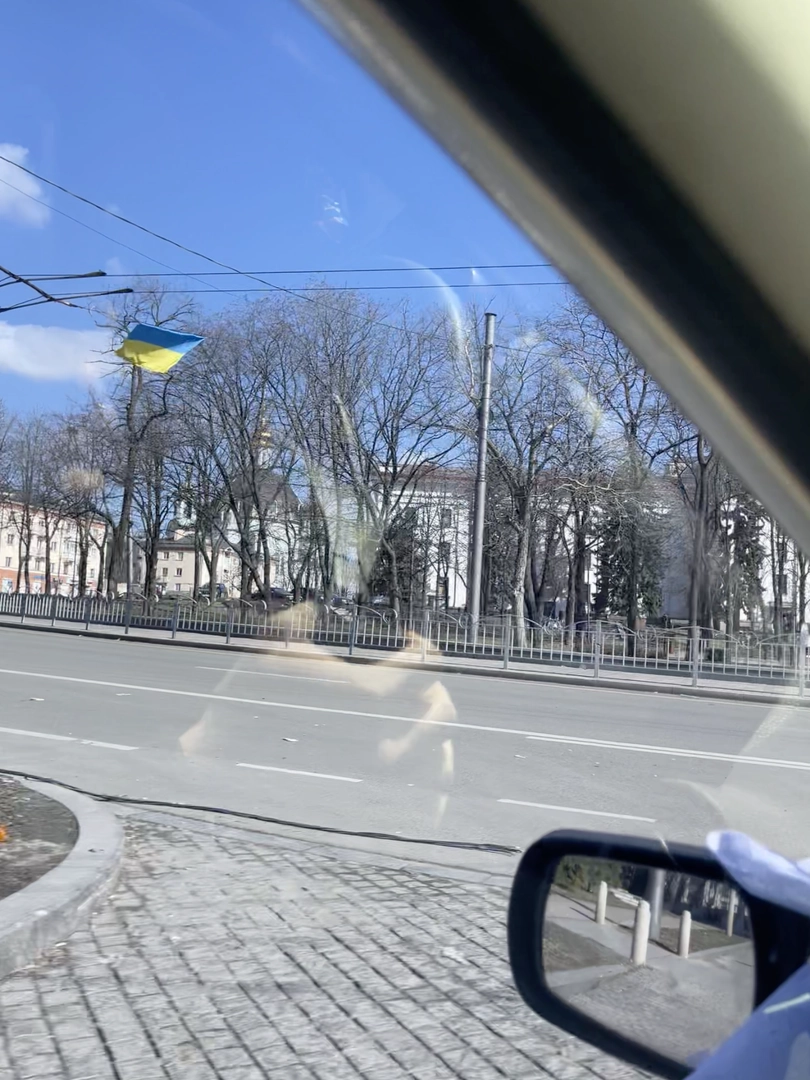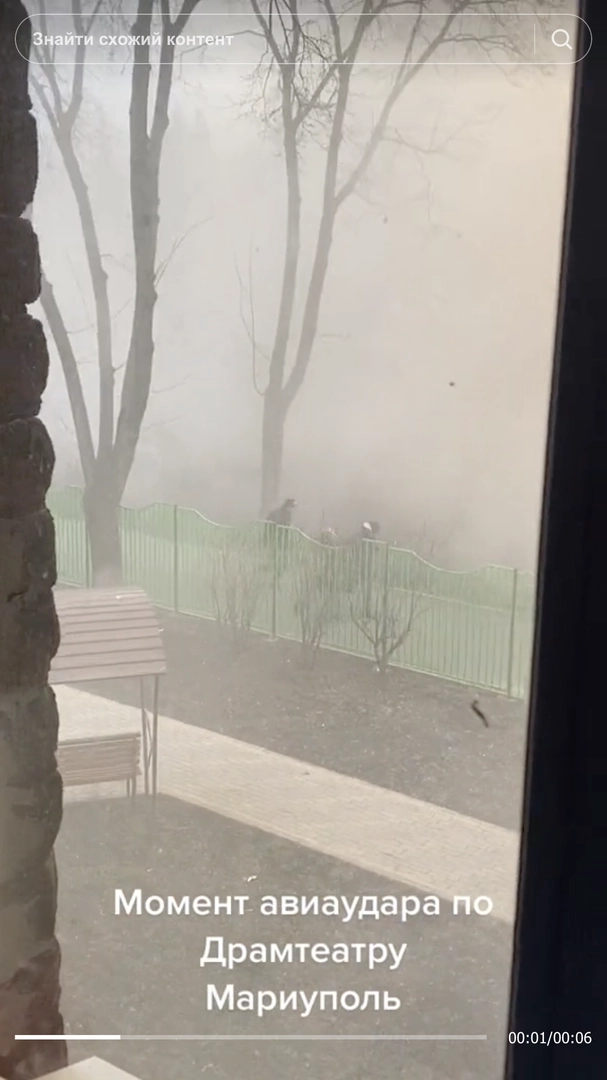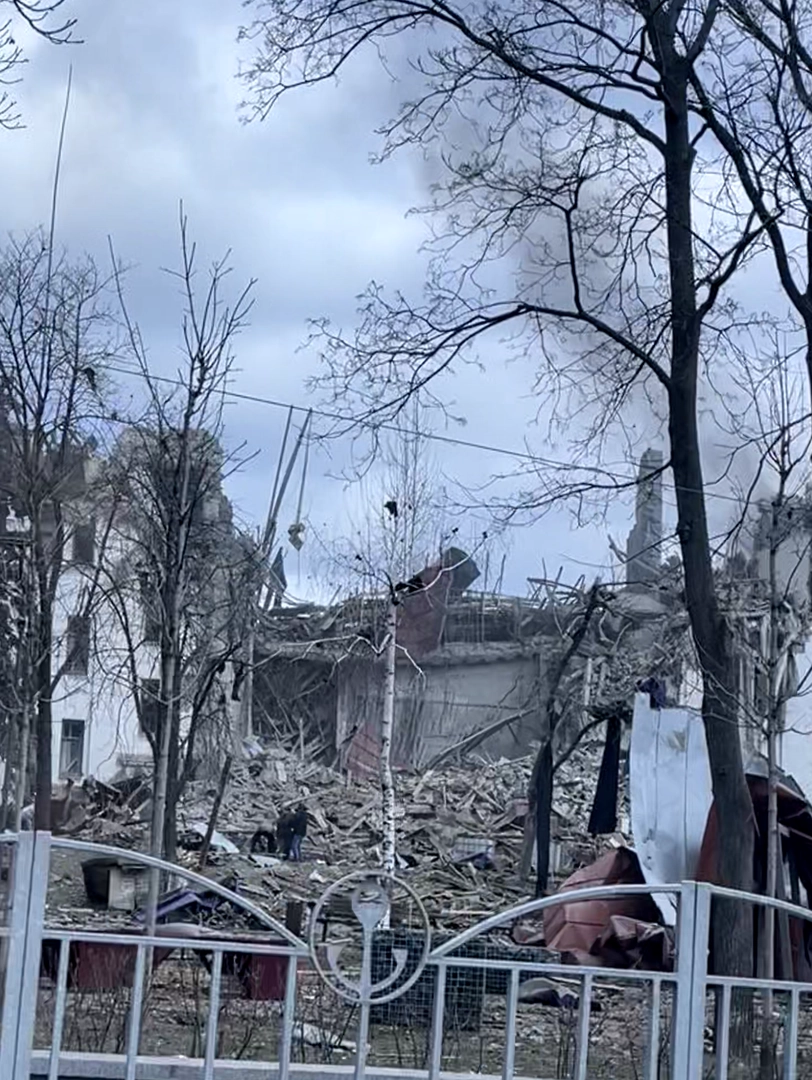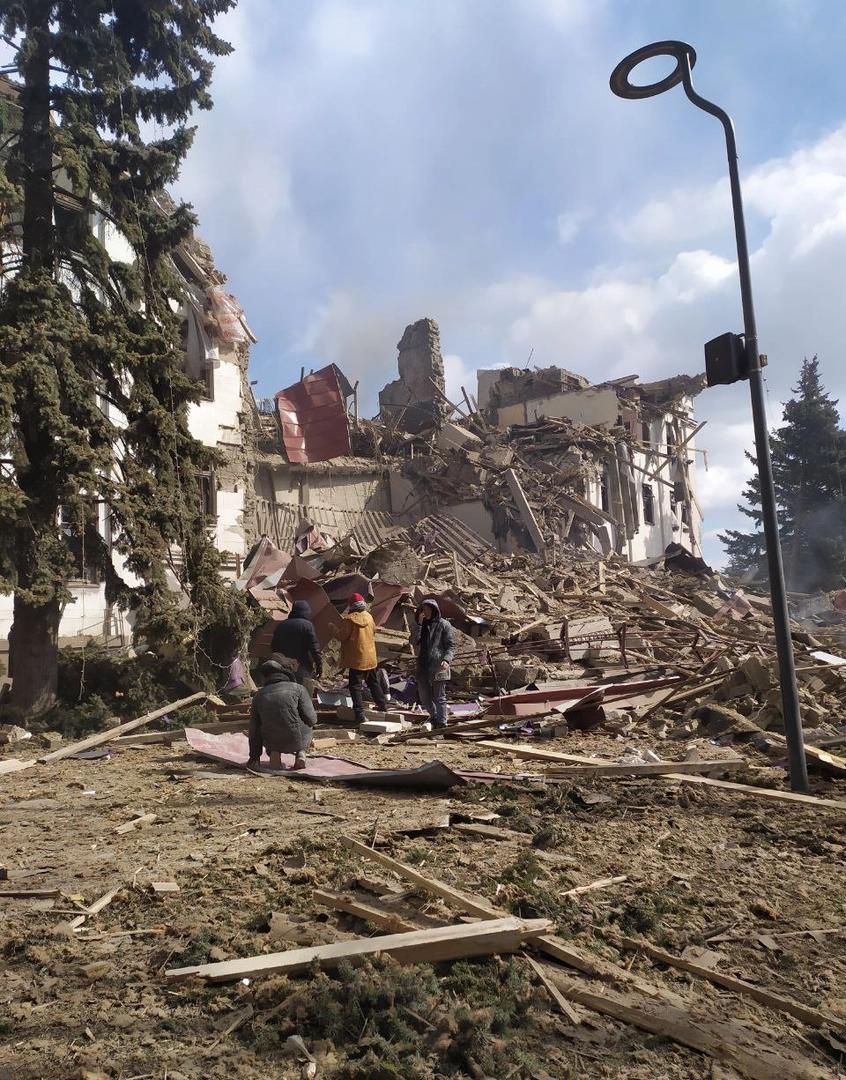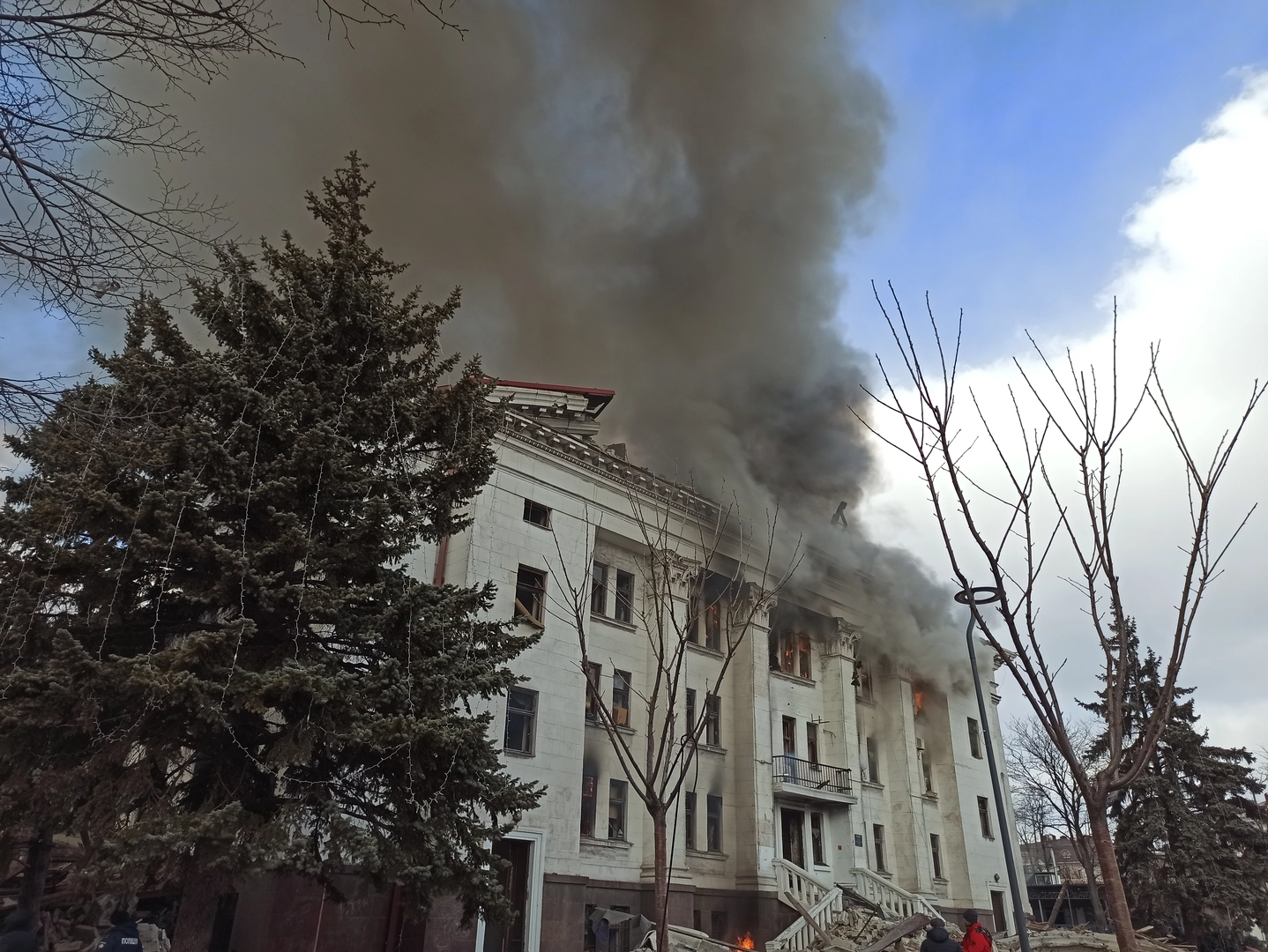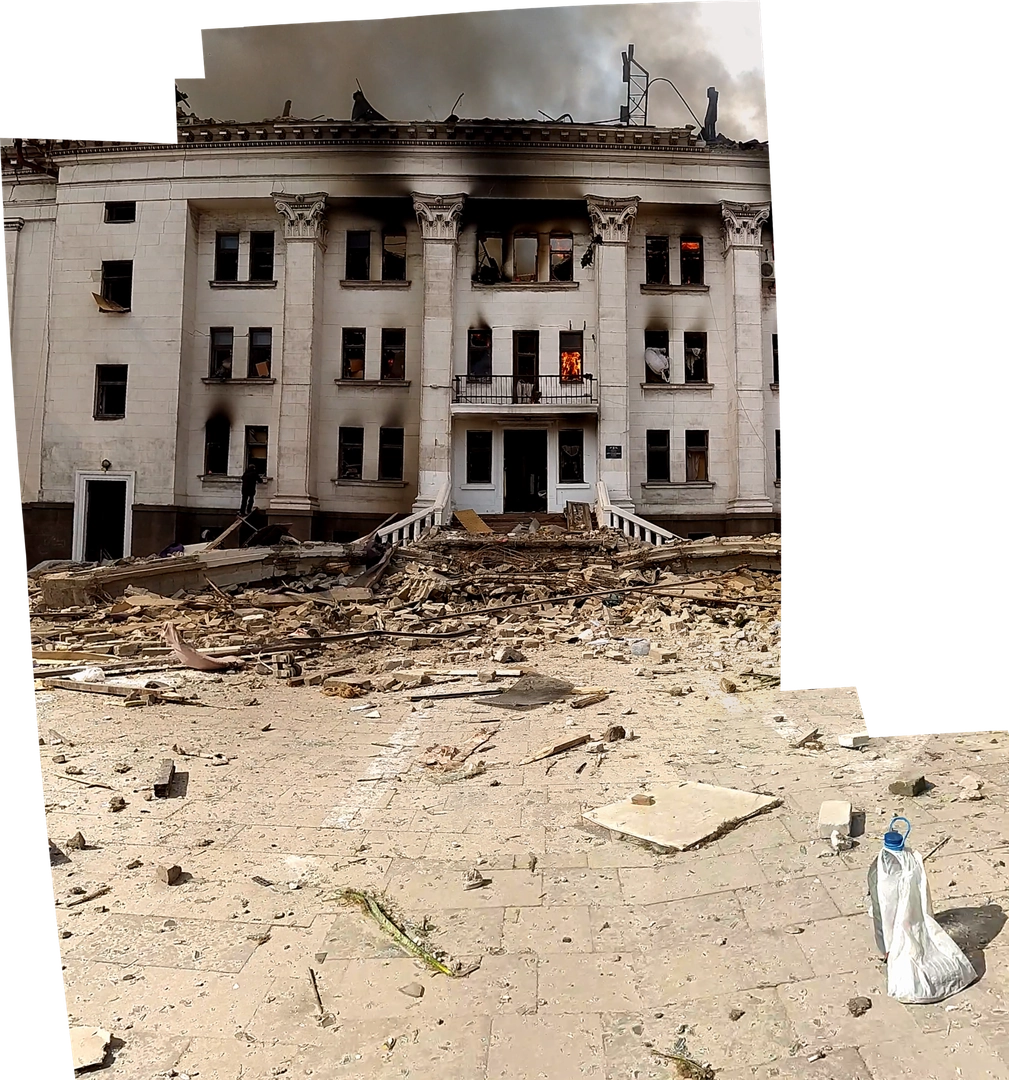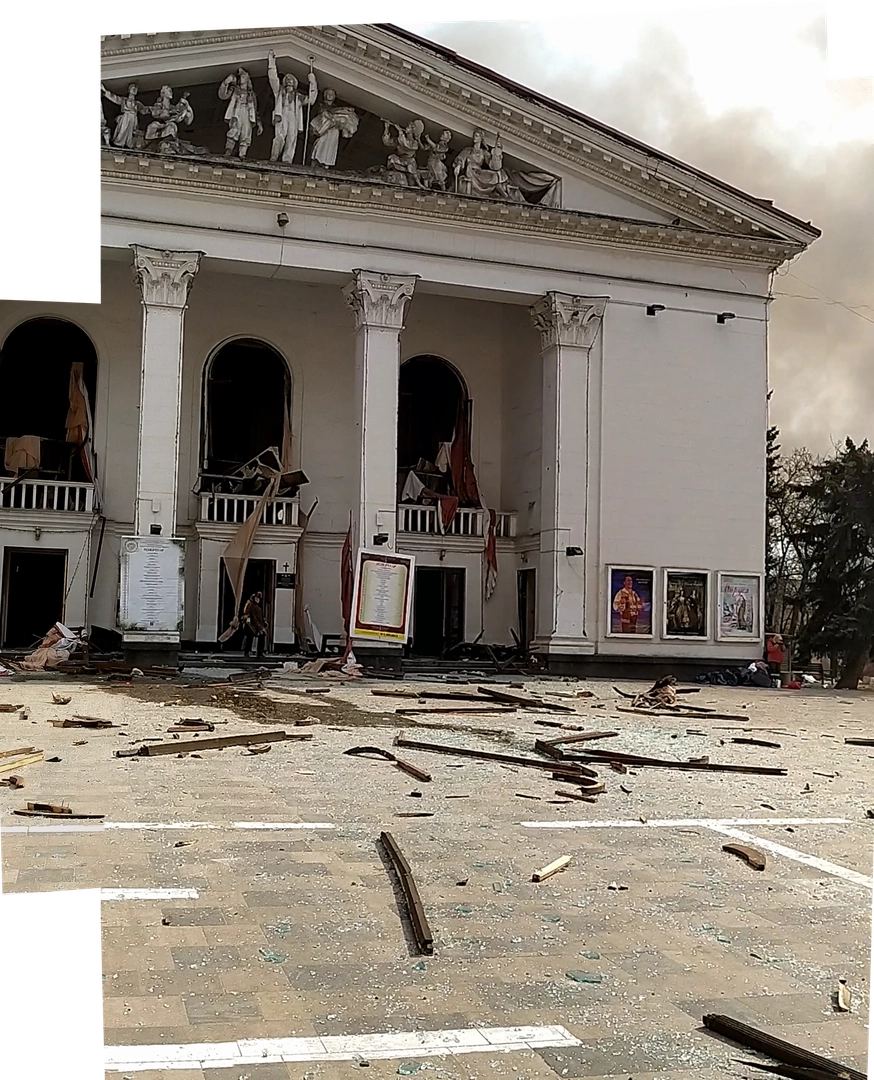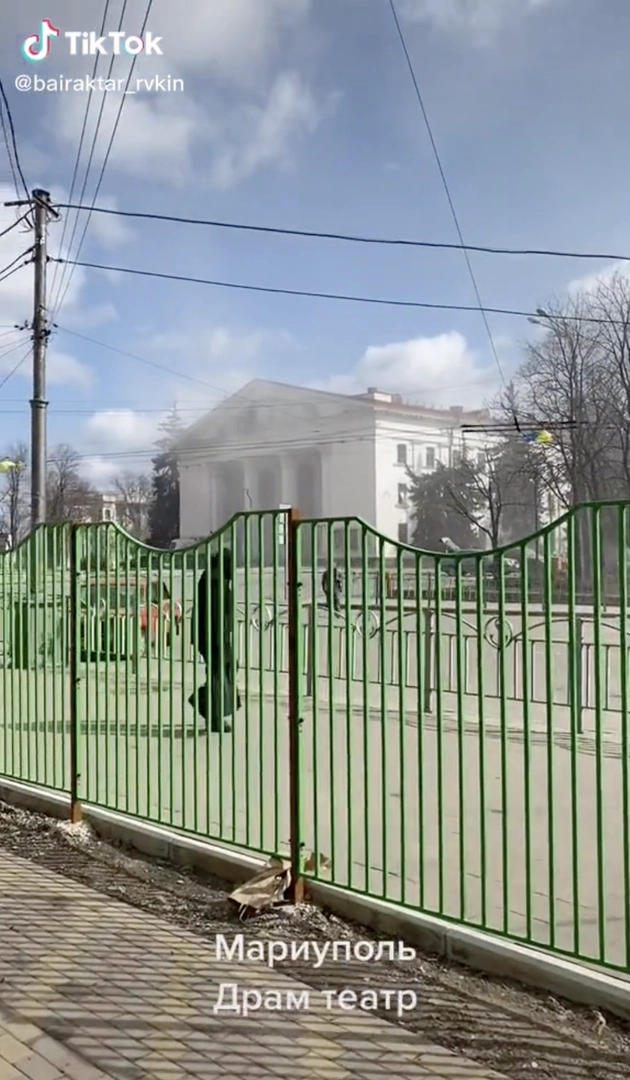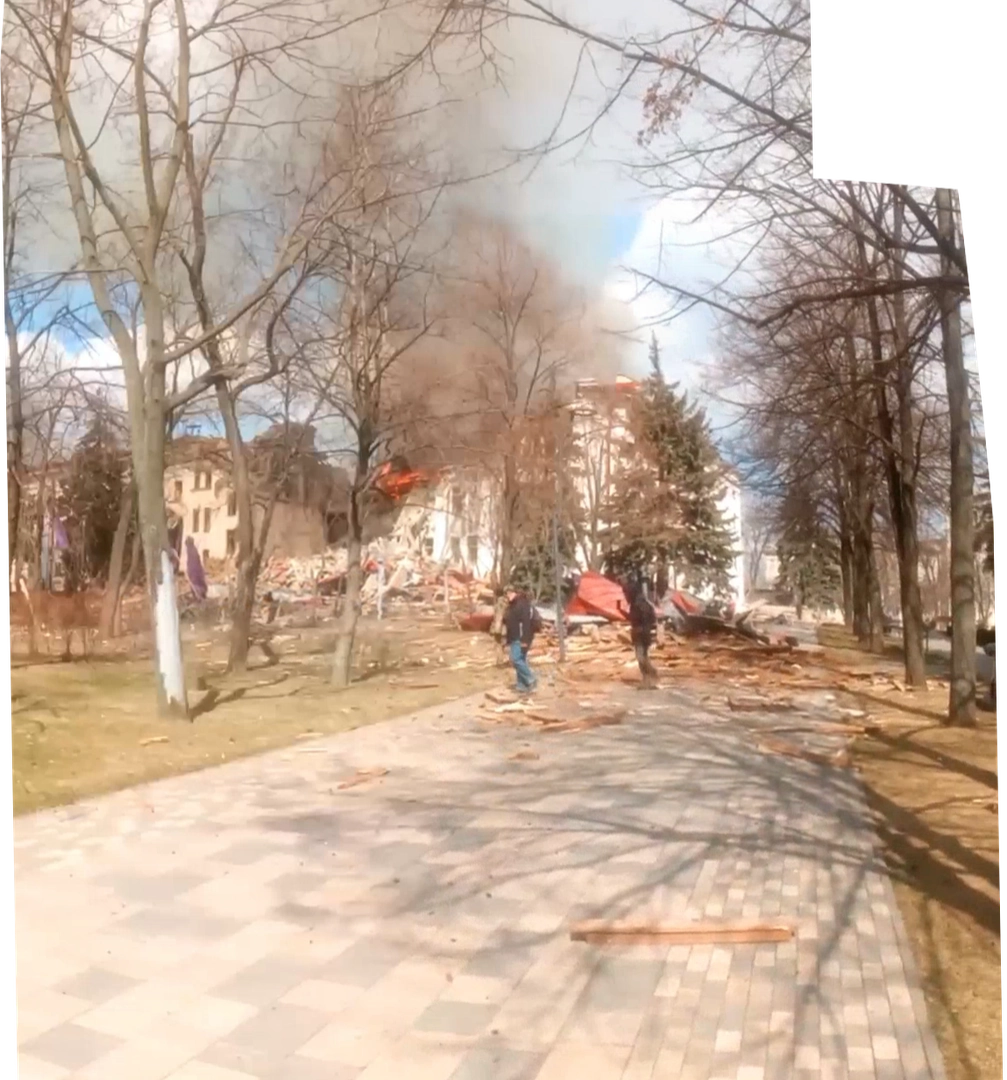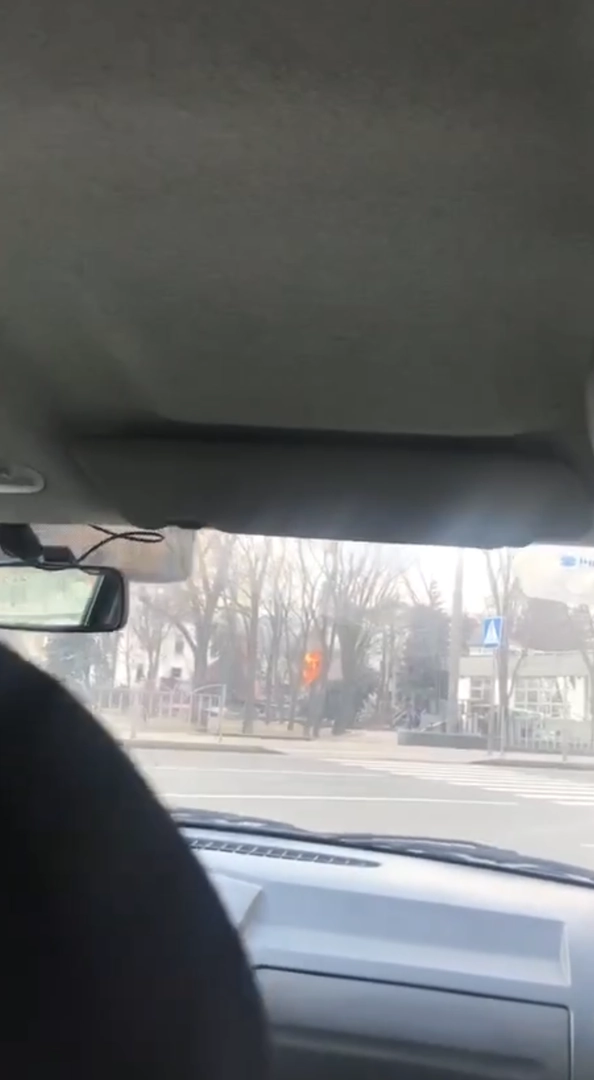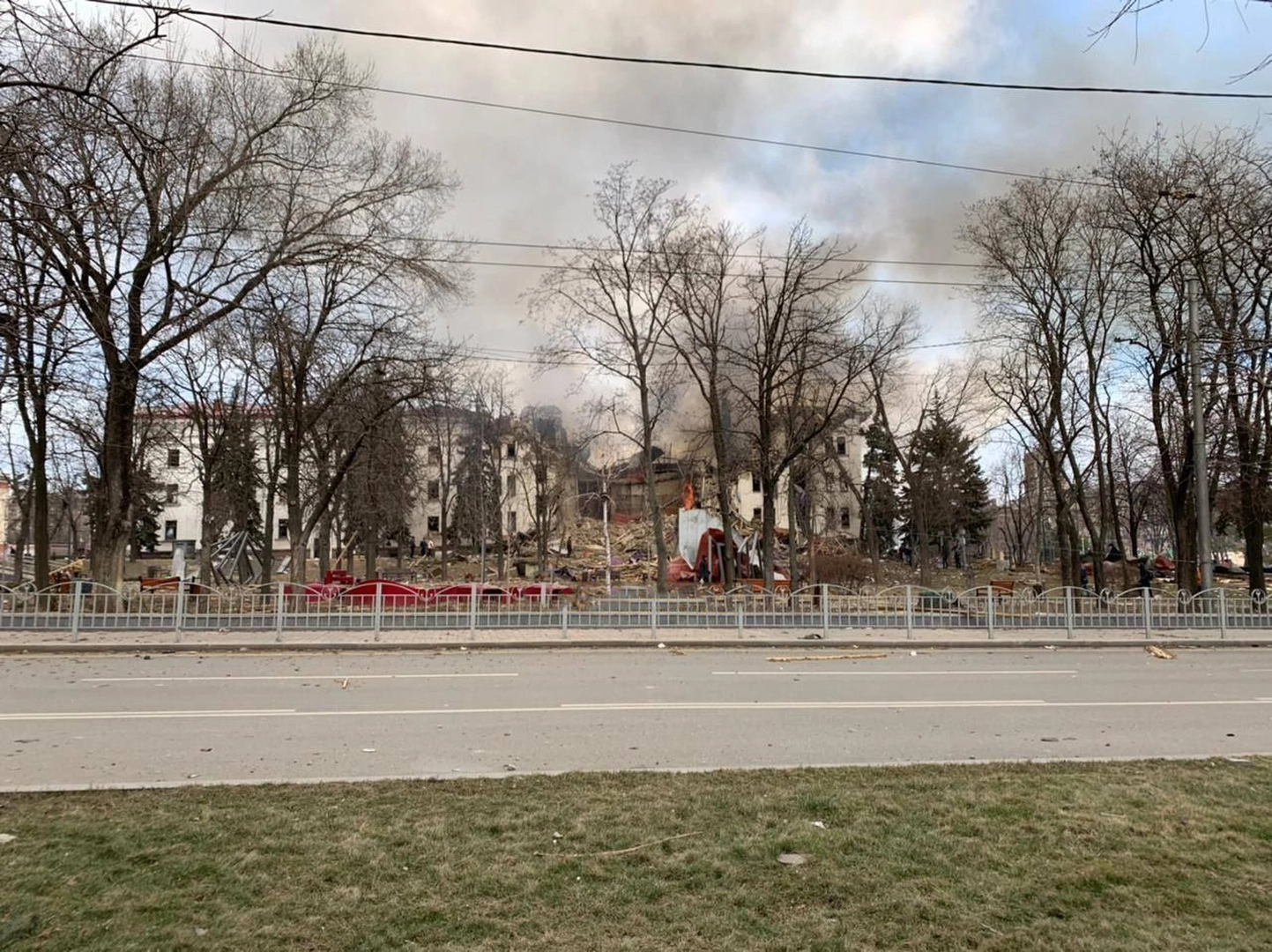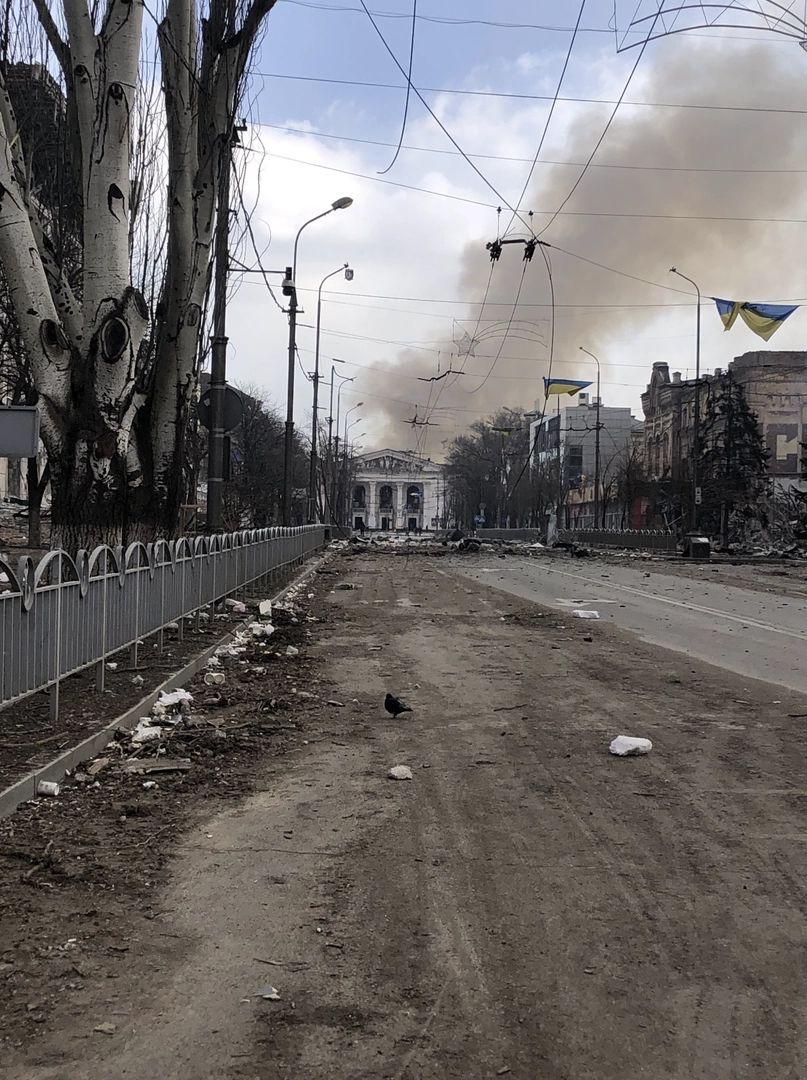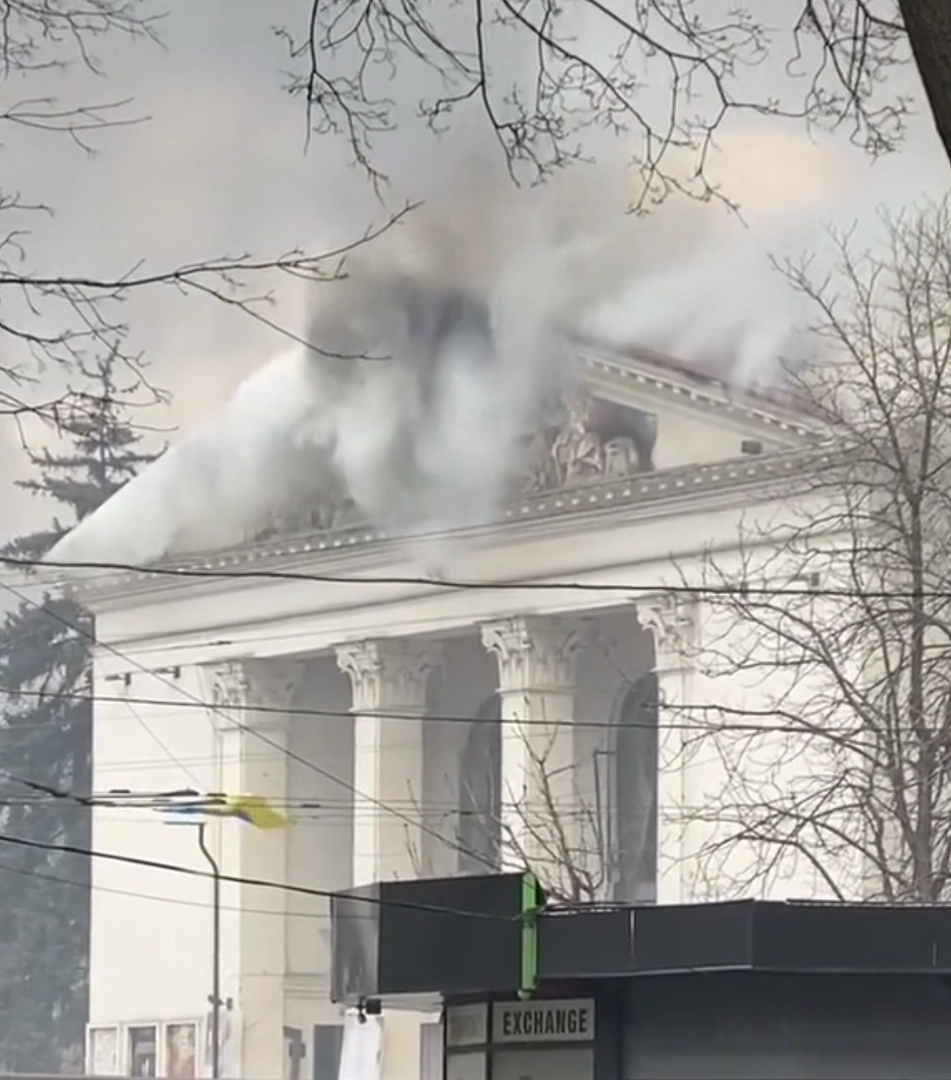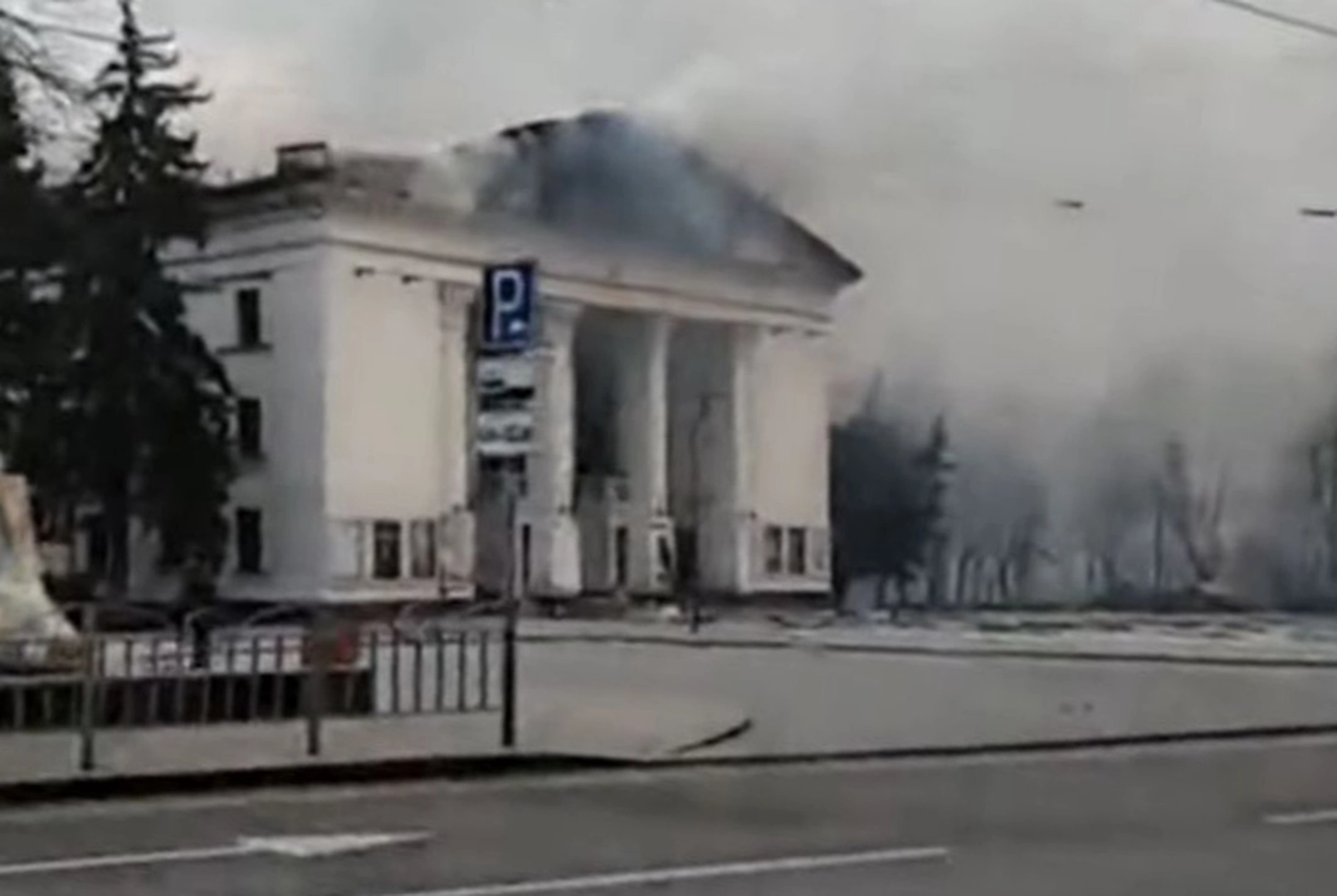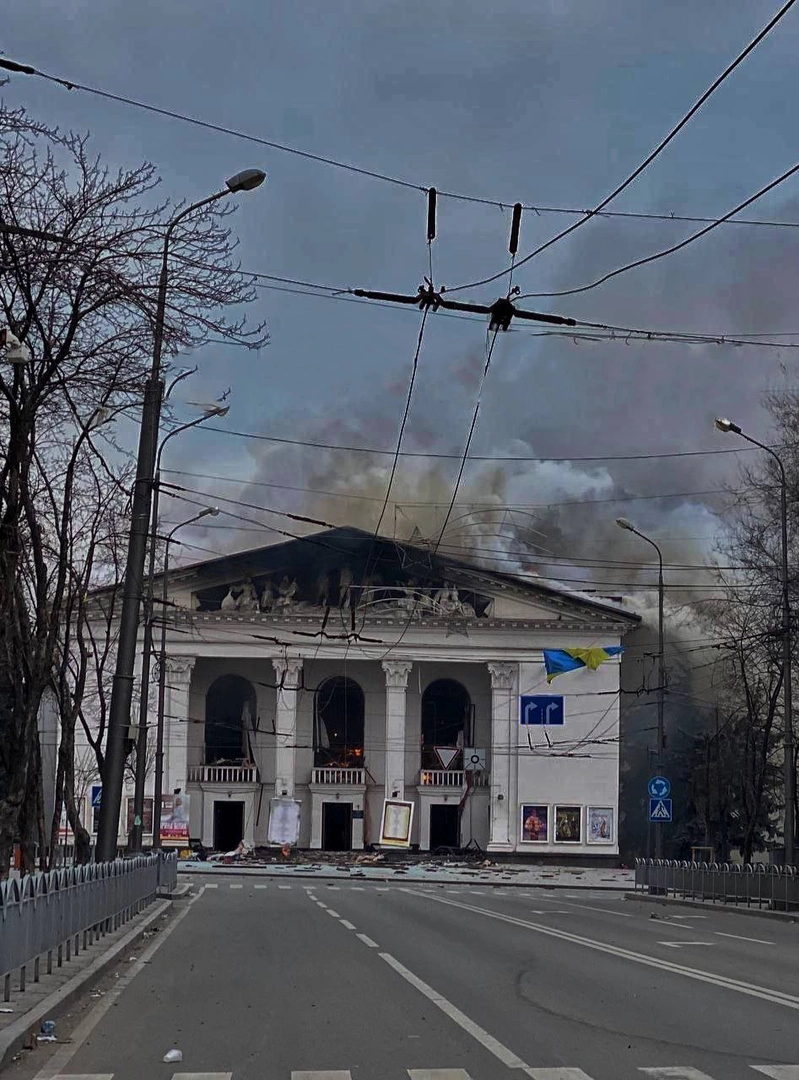On the morning of March 16, 2022, the army of the Russian Federation bombed the Mariupol Drama Theater, which served as one of the largest civilian shelters in the city, hosting at least 2,000 people between the beginning of the full-scale invasion and the moment of the airstrike. The attack was committed under a military and information blockade, as well as constant bombardment of the city center by the Russian army.
Since the city’s occupation, access to the ruins of the Theater for human rights organizations and the prosecutor’s office has been blocked by the Russian authorities, and the remains of the building—the main evidence of the crime—have been completely demolished. These actions complicate the forensic process and make it almost impossible to identify the exact number of victims.
In-depth interviews with 27 eyewitnesses1As a part of the study, we have conducted spatial interviews with 12 witnesses and in-depth interviews with 15 witnesses. The interviewees were residents of Mariupol and the neighboring towns staying in the Theater or nearby during the blockade or at the time of the attack. This text uses quotes from the interviews, which we quote verbatim with the original wording and speech characteristics of the witnesses. You can watch and read abridged versions of the 12 interviews here. have helped us combine information from photos and videos into 3D models to understand the dynamics of life in the Theater before and on the day of the attack. We have documented the aftermath of the attack, the nature of the destruction, the spaces most affected by the explosion, and the experiences of eyewitnesses who managed to escape; we also made assumptions about the type of weapon used in the attack. The collected materials show the Russian air strike on the Drama Theater building from different perspectives and indicate that it was not accidental. “Scorched earth and only the Drama Theater is there”: Mariupol before the attack
The situation in Mariupol deteriorated significantly the night before March 16, 2022. As more and more buildings were destroyed, the city seemed to shrink, and the fighting got closer and closer to the city center—and to the Drama Theater. The urban space was falling apart under the Russian Federation’s continuous bombing, and the destruction could be felt within the Theater’s walls2Read more about the situation in the Theater, the city, and the escalation of events until March 15, 2022, in the text A City Within a Building. . The city had fewer and fewer resources to support the Theater, and the municipal services, the police, and the TDF3The Territorial Defense Forces of the Armed Forces of Ukraine (Territorial Defense Forces, commonly referred to as the TDF) are a separate branch of the Armed Forces of Ukraine. Until May 2022, they were supposed to perform tasks within the territory of their respective community, and later their activities were expanded to the area of combat operations. Although it was already possible to join the TDF before the war escalated in 2022, the process intensified with the full-scale invasion. In Mariupol, under constant shelling and with most institutions evacuated, the formation of the TDF was rather chaotic, and people often joined unofficially on the spot, essentially on a volunteer basis.
were severely exhausted. Most of the municipal services at that time often acted on the initiative of the employees themselves, but as the siege intensified, it became increasingly more difficult for them to work.4Witnesses said that until about March 10-12, 2022, the police continued to help the Theater by supplying food and essentials, as well as transferring the necessary items from other large shelters in Mariupol. But later, the police stopped coming to the Theater.
The city was under an information blockade due to the absence of electric and mobile communication, as well as the evacuation of most journalists.5The last two journalists who continued to document the situation in the city, Mstyslav Chernov and Yevhen Maloletka, left on March 22, 2022. During their stay in Mariupol, the Russian authorities announced a “hunt” for them. In the Drama Theater, one could sometimes catch Ukrainian radio waves, but they were also blocked by the radio channels of the so-called “Donetsk People’s Republic.” During their stay in the Theater, people made several attempts to evacuate on their own. However, only two days before the bombing, on March 14, 2022, the Russian side began to let civilian cars leave the city for the first time, which became known de facto, without an official announcement6The existence of the de facto humanitarian corridor was confirmed at the time by Petro Andriushchenko, advisor to the mayor of Mariupol. . Therefore, on March 15, about half of the people from the Theater left the building. Despite the establishment of the de facto humanitarian corridor, those who managed to leave the city did so without any security guarantees from the Russian authorities. Some Theater residents exchanged contacts with those who decided to leave. On the morning of March 16, the latter informed those who stayed in the Theater that they had safely reached Ukraine-controlled territories.7At the same time, not all families were able to leave the Theater. Mostly because the evacuation was carried out by private cars. The Russian side was constantly blocking the supply of evacuation vehicles to the city, and therefore people who did not have their own transport were left in the most vulnerable position.
On the night of March 16, explosions were getting louder and louder: buildings located on the streets adjacent to the Theater were damaged. In particular, witnesses mention the bombing of the Ukraina shopping mall, 300 meters from the Drama Theater. One witness, Dmytro Murantsev, said that it seemed to him that the city had turned into scorched earth, with only the Drama Theater remaining intact. Yevheniia Zabohonska8Before the escalation of Russia’s war against Ukraine, Yevhenia Zabohonska had worked at the Theater as a lighting director for 20 years. She became one of the key people in the Theater’s volunteer group, namely the Drama Theater’s “commandant,” as the Theater’s residents themselves called her. Read more about the processes of self-organization in the article A City Within a Building.
, the coordinator of the Drama Theater volunteer group8Before the escalation of Russia’s war against Ukraine, Yevhenia Zabohonska had worked at the Theater as a lighting director for 20 years. She became one of the key people in the Theater’s volunteer group, namely the Drama Theater’s “commandant,” as the Theater’s residents themselves called her. Read more about the processes of self-organization in the article A City Within a Building.
, described the feeling from intense shelling of the neighborhoods near the Theater that night: “Missiles just kept flying endlessly, the ground was shaking. [...] [This was] the first time in three weeks that I was scared. Whatever happened before, no matter if a mine blew up somewhere or something fell, I just completely ignored it [...]. That night, I was scared out of my mind, mad with fear. I didn’t sleep, [...] people didn’t sleep in the Theater at all. People sat there by candlelight and prayed, the guards didn’t sleep, nobody in the Theater slept.” We have created a media evidence map that combines videos and images provided by witness Oleksandr Rubets in order to visualize the degree of destruction in the city. Oleksandr arrived at the Drama Theater from Manhush, which was occupied in early March, less than an hour before the attack to help his friend evacuate. The videos document the heavy shelling of the city, and some of the footage was shot near Russian army positions in Mariupol. Oleksandr also documented the view of the Theater and the square around 9:30 a.m. on March 16, showing the destruction of roofs, facades, and windows in the buildings in the square around the Theater. 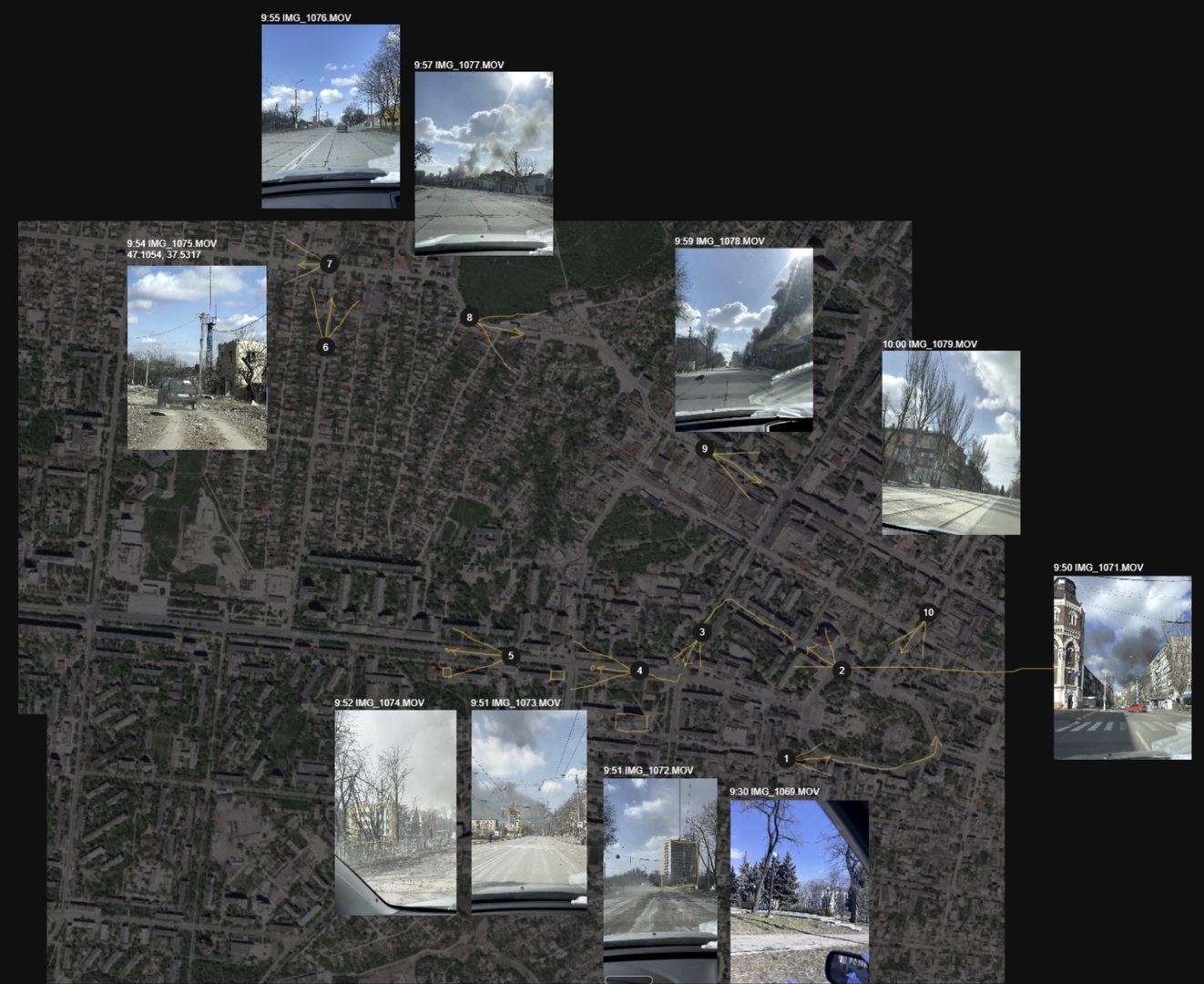
A map of Oleksandr Rubets' route on the morning of March 16, 2022 + footage from the video. Oleksandr deleted part of the video after he left Mariupol. The witness considered it unethical to preserve or potentially disseminate such images, as they documented the bodies of the dead on the streets of the city. ©Center for Spatial Technologies
Although the Theater’s distance from other buildings and location in the very center of the city reduced the likelihood of an accidental shell hitting the building, the destruction was getting closer and closer to the Drama Theater.
Theater on the eve of the bombing
Even though some people had left the Theater, the dynamics of the processes in the building, as described to us by witnesses, allowed us to understand that the space continued to function as a central and one of the largest shelters in the city on March 16, 2022. We assume that there were at least a thousand people in the Theater at the time of the attack who continued to follow the rhythm and safety rules established in the Theater during the weeks before the strike
Yevheniia Zabohonska, a Theater employee and coordinator of the building’s volunteer group, described a significant reduction in the number of people in the Theater on the day of the attack: “And so, in the morning of 16 March, I was scared out of my mind. [...] at 7:00 a.m., right at sunrise [...] [it] just felt like the Theater was cleared out. The Theater got so empty that I had never seen it like that in those three weeks. [...] So many people left at that time [...]. But still, as soon as people left, right away, from around 9 a.m., new people started coming in the hope of being evacuated.” As she felt that the situation was getting worse and worse after the bombing of the night before March 16, Yevhenia, who continued to manage the volunteer movement in the Theater, also began to prepare for evacuation from the building.
On the morning of March 16, Theater residents and people sheltered in nearby blocks continued their attempts to evacuate. Oleksandr Rubets, a witness of the attack, testifies that right before the attack, the locals tried to find cars that would take them out of the city: “There were mostly women standing there [trying to hitch a ride]. [...] There were at least 50 people. On both sides, they stood there scattered along the way, but they actually acted very aggressively, you could say. I mean, if I was driving a bit more slowly, they’d jump in front of the car.”
That morning, people in the Theater, and the entire space along with them, were in active movement. When around half of the residents left the building, some of the space on the first floor and in the bomb shelters became vacant. Due to this, people were able to relocate to the bomb shelter or to safer rooms and spaces with thick walls, which could potentially protect them from a missile strike or shrapnel.
The main hall was avoided by the Theater residents, just like during the previous weeks of living in the shelter, because it was considered to be the most dangerous room.9 Despite this, however, there were still people in it. A witness of the attack, Mariupol resident Mariia Rodionova, who lived in the hall, recalled that there were very few people in there before the attack, just one family. At the same time, Oleksandr Rubets, who visited the stage about 20 to 30 minutes before the attack, noted that there were around ten people in the hall. Nevertheless, the Theater continued to follow the rhythm of life that had been established by its communities during the first weeks of living together. The residents had the time to heat some water, cook food, and have breakfast before the Russian army targeted the Theater. Yevhenia Zabohonska recalled: “We made dough for the bread the night before, [...] our entire life was following the established track: bonfires, bathrooms, cleaning up, a status meeting. It was all routine. Then we [tried] to find some more room to settle people.”
In the morning, the volunteers cooked the same amount of food as any other day, but since there were fewer people now, for the first time in a long while there was enough breakfast for everyone and even some leftover portions. The field kitchen was handing out the leftovers from breakfast and as they began to cook lunch.
Besides the chaos of the evacuation, the area surrounding the Drama Theater bustled with activity throughout the ordeal. In addition to seeking medical assistance, residents from various streets also converged on the Theater to access water, food, or charge their phones.10In early March 2022, electricity, heating, and gas supply were cut off in the city due to constant shelling. People would also go out to the green areas in the square to walk their dogs. For instance, eyewitness Mariia Rodionova shared how she took her two dogs for a short walk in the morning and fed them some leftovers from the field kitchen. After that, she secured her pets on a leash near the place in the Theater hall where she slept, and then she went outside. Mariia Rodionova also reports that a few minutes before the attack, a queue of about ten people formed in front of the central entrance to the Theater to collect water from a water tanker that was parked there. Mariia was among them. An anonymous witness of the attack in the morning of March 16 came to the Theater from a neighboring block to charge his phone and collect some water on the other side of the building, from the utility well next to the field kitchen. He recalled: “Initially, there were lots of people there, there was a queue of people standing around the Drama Theater with me.”
Bombing of the Drama Theater
During the airstrike, one or two 500-kilogram aircraft bombs pierced the roof of the Theater and detonated midair, likely near the Theater’s stage. 11Based on the findings of defense and security consultant Gareth Collett and an analysis of the damage in the Theater, we assume that the bombing was carried out using one or two 500-kilogram bombs equipped with fuses to delay the explosion. According to Gareth Collett, the type of damage to the building most likely indicates that a KAB-500C-E guided bomb was used in the attack. More information about Gareth Collett’s findings on the weapons used in the attack can be found here. The use of two bombs in the attack is also confirmed by the analysis conducted by Amnesty International and McKenzie Intelligence Services. At the same time, Amnesty International suggests that two FAB-500 unguided bombs were used in the attack. The bomb penetrated the roof over the Theater stage in the central part of the building and detonated within milliseconds of impact, causing a spherical blast wave that spread through the building. All people who were within 21 meters of the direct line of sight of the explosion’s epicenter were killed, and the area affected by the explosion debris was 207 meters across (Collett, 2023). Testimonies about the air strike moment
Immediately before the attack, some of the witnesses who were outside or near the windows heard the sound of a military aircraft. Their recollections helped us record the moment of the air strike. Mariia Rodionova testified: “I was actually standing right at the front next to the tanker. There was a jet sound, and people from the square rushed to the Theater. Some people were smoking, some were standing there next to the cars, some were trying to hitch a ride, [but at the moment of the attack] they all rushed into the Theater.”
Images documenting the traces of air strikes and eyewitness accounts from the scene.
Similarly, an anonymous witness who was collecting water from a technical well near the field kitchen recalls hearing the sound of an aircraft just before the air strike: “I stand there, step on the manhole on both sides, lower the bucket, and at that moment we hear the noise of a jet. Well, that’s kind of scary, but we’re all more or less used to it by then. So we figure, well, are they totally batshit to drop a bomb on the Drama Theater? Then an explosion roars, and I’m still filling the bucket.”
Oleksandr Myronenko, a member of the Theater’s volunteer group, was on the second floor of the building before the attack on the Drama Theater. Oleksandr also witnessed the bombing of Maternity Hospital #3 on March 9. He recalled hearing the sound of an aircraft before the attack on the Drama Theater, very similar to the one he heard before the attack on the Maternity Hospital. “I could hear it [the aircraft] coming down. And when it got really loud, the windows flew out,” recalled Oleksandr. At that moment, he was in the building and did not realize that the bombs had hit the Theater: “It was only 10 minutes later that I found out that the Drama Theater was hit. I thought they were shooting somewhere nearby, from the side of the field kitchen, but it hit the building.” Oleksandr Myronenko is not the only witness who did not immediately realize where the bombs hit. “I heard something like an explosion, but I didn’t pay that much attention, [I did not realize] that it was in the Drama Theater,” said an anonymous witness who was driving up Italiiska Street, a few blocks from the Theater, at the time of the explosion: “We then drive there [...] and I see a destroyed part of the Drama Theater. I see a fire, some smoke. [...] Later I just realized that it was the Drama Theater that was hit. [...] We were in complete shock. With my last strength, I started to run [...] to the entrance.”
Affected areas and consequences of the airstrike
Eyewitnesses and images from the site of the attack show that the stage and hall of the Drama Theater, the rooms adjacent to the hall, the spaces on the second and third floors, the field kitchen, the area around the technical well, and the Theater Square itself suffered the most damage as a result of the air strike. Even the basement near the stage turned out to be dangerous. The only place that withstood the air strike and did not suffer severe damage was the bomb shelter.
The explosion caused the collapse of the outer walls and walls around the Theater stage, as well as the ceilings of the adjacent rooms. Yevheniia Zabohonska and Serhii Zabohonskyi were closest to the explosion's epicenter, in the electrical workshop at the back of the stage. This room had fireproof doors that were closed at the time of the impact. It protected Yevheniia and Serhii from the blast wave. Nevertheless, they were seriously injured and trapped under the rubble. “In just a few seconds, everything around us had turned into a mass of splinters, shatters, mass of debris. In an instant, there was nothing whole left,” said Yevgeniia. “It was impossible to go backstage. [...] All the cables, pipes, metal from the stage lights, which were about five pieces of several tons each, were all tangled, like in horror movies. [...] The hall and the stage before the blow were separated by a fire curtain made of asbestos. And this asbestos scattered in all directions at the moment of explosion.” Mariia Rodionova, who was outside, also recalled that some people managed to hide in the building after hearing the sounds of the aircraft before the air strike. However, there were several wounded people outside, and she was saved from the debris by another resident of the Theater. It was a miracle that she managed to survive, as she spent most of her time in the Theater, where her pets remained at the time of the strike. “Whatever they say, my dogs were like family to me,” recalls Mariia Rodionova. “I dashed there to check what’s what, to find them [...]. I walked around the Theater for hours, hoping to find a way in, but it was all blocked up with rubble. [...] Everyone who was in the hall, I think that everyone who stayed there at that moment, they all died.”
In addition to those in the stage hall, most of the victims were on the ground floor, in the food preparation rooms and near the Theater. They were trapped under the rubble of the theater walls. “Fragments [...] covered us as if by inertia. [...] The back wall [was destroyed]—you could see the sky through it [...]. The floor above us didn’t exist anymore,” described Ihor Navka, a Mariupol resident and Theater volunteer who was on the first floor in the food storage rooms at the moment of the explosion. Vitalii Tsesar, who was with his family and other Theater residents in the basement below the space near the stage where food was prepared, described the collapsed room dividers and the severe damage to the building. “One [concrete slab that served as a room divider] fell on my back; the other one fell on me and slipped along my head,” said Vitalii Tsesar. “[It] fell on my back, crushed me, pressed me really hard against the table.” He also recalled that one of the women in that room had her chest broken, but she was saved. The field kitchen, as the Theater’s residents had predicted, was the other most vulnerable place in the Theater. It was completely buried under the rubble of the collapsed walls and roof, which had scattered from the building’s facade within a radius of 207 meters.
Most witnesses described a large number of injured and killed on the ground floor, in the hall, and outside near the entrance. Witnesses recalled seeing immobilized people lying on the stairs between the first and second floors. Some of the fragments of plywood that had been used to board up the windows flew into the hall and killed a person. Additionally, many victims were in the area of the field kitchen and in the area next to it, which were covered in debris and wooden boards.
In the first seconds after the airstrike, the entire building was also covered with dust from the explosion, which, according to witnesses, exacerbated disorientation in space. In the darkness and dust, people were trying to find a way out of the building. Oleksandr Rubets was in the hall during the air strike and accidentally documented the first seconds after the bombing on video. He tried to turn on the flashlight on his phone but instead turned on the camera and filmed the first video evidence after the air strike. The video’s metadata shows that the attack on the Theater took place at 10:05 a.m. However, satellite imagery first documented the already destroyed Theater building on March 16 at 10:20 a.m. Combining these two media pieces of evidence allows us to understand the exact time of the air strike and to see the gap between the horizontal image taken from inside the targeted space and the verticality of a remote view from a safe distance.
Consequences of the attack: secondary destruction and systematic terror
Besides the Theater's direct bombing, a significant number of casualties resulted from the Russian army’s deliberate destruction of essential infrastructure and the implementation of a wide range of tactics, all part of a coherent strategy aimed at instilling fear in the local population through systematic acts of terror.
These actions made the rescue of those who were seriously injured impossible and led to the loss of hope for rescue among other people in the Theater after the air strike.
Despite the general panic and injuries, a significant number of people remained at the location of the attack, helping to rescue victims from under the rubble. At that moment, Mariupolians were outside, still listening to the sounds of the plane that continued bombing the city. “It was hard to look at, because there were so many injuries. [...] The most tense moments were when the jet was flying around. [...] It dropped a bomb, a little bit, it was somewhere a bit higher than the Drama Theater, and the explosion was there. [...] It flew very low there, so low that all of us [the people who were helping the injured or standing outside] dropped to the ground,” recalled an anonymous witness. “But they [firefighters] were in shock themselves. They didn’t know where to take people, you know? [...] There were so many wounded, but few cars.” According to him, municipal workers also came to the Theater in civilian cars to help transport the injured.
Oleksandr Myronenko, who also helped people get out, recalled that no one could be rescued from the rubble of the field kitchen: “Other people [who managed to escape from the Theater] ran there, but [they saw that] there was even no point in getting people out, because it was just a slab on a slab—there was no clear space at all.”
Most witnesses described the feeling of despair and complete powerlessness after the air strike. Oksana Mazina and Dmytro Murantsev recalled a large number of victims whose screams could be heard from under the rubble near the exit in the right wing of the building. However, they both described being unable to help them due to the heavy weight and size of the debris, the lack of special equipment, and the fear of another attack on the building. Oleksandr Myronenko also said that some of the victims felt powerless after the air strike and asked to be left without first aid: “This woman who was lying here [in the hall on the first floor] told us to leave her alone. And on the second floor, right here [in the passage to the auditorium on the second floor], an old lady was sitting alone, and she also said, ‘I'll stay here’.” A fire started in the Theater while people were trying to rescue the victims. The firefighters who arrived at the location had heat-resistant gear, so they were able to help people save the injured and take the remaining medications, which had not been burned yet, out of the medical room. The medications were also used to provide first aid. But despite the firefighters’ help, it was impossible to extinguish the fire without access to water, and some of the people who were still trapped in the rubble could not be rescued.
Moreover, the number of victims increased due to the destruction of the city’s medical infrastructure during the weeks preceding the siege. Therefore, some of the severely injured people who lost a lot of blood and had serious fractures were unable to receive medical care on time. An anonymous witness who was helping the victims after the airstrike noted: “It was so hard […]. You know, you’re mentally crushed, and you don’t even know what to do first. You realize that the only thing you can do is some bandaging or a shot of medicine. That’s it. The only thing [that helped] was that the rescue workers arrived in their own cars and took [the injured] away somehow. And even their eyes were like, ‘Where do we take them? We don’t know where’.”
After the attack, all witnesses had to evacuate the city on their own. This evacuation involved crossing filtration camps, moving through the areas where active hostilities were taking place, and leaving through the temporarily occupied territories. Many civilians trying to escape ended up being deported to the Russian Federation. Moreover, one of the witnesses was forced to hide in the temporarily occupied Mariupol for several months because the checkpoints of the occupation authorities controlling the exit from the city were informed that he was a member of the TDF.
**
The Mariupol Drama Theater was deliberately chosen as a military target by the Russian Federation army for an air strike that happened at 10:05 a.m. on March 16, 2022. The most vulnerable spaces of the building sustained the highest degree of damage as a result of the explosion: the Theater stage, the auditorium, as well as the adjacent rooms on the first, second, and third floors, the field kitchen, the areas around the technical well and the Theater Square. We estimate that at the time of the strike, at least a thousand civilians were in the Drama Theater. Despite the de facto emergence of a humanitarian corridor, people continued to gather in the building.
The act of deliberate terror by the Russian army not only resulted in hundreds of Mariupol residents dying from the direct effects of bombs hitting the building but also in a large number of the dead being trapped under the rubble of the Theater and in a major fire which could not be extinguished due to the destruction of the city’s infrastructure. The number of victims also increased because the seriously wounded could not get first aid. The evacuation from the city lasted several days and was carried out under constant shelling without any security guarantees.
The air strike, information blockade, destruction of urban infrastructure, filtration camps, and instant erasure of all evidence of the crime under the occupation expanded the terror against Mariupol residents, the beginning and end of which are difficult to track. This erasure is an important part of the Russian army’s tactics aimed at creating distance from the crime in space and time. With each subsequent urbicide, the front line is pushed deeper into the map and further away from the morning of February 24 or March 16, 2022. While blurring the events of the siege with thousands of bombings that erased Mariupol, this distance remains synonymous with the systematic impunity of Russian imperialism, which is consolidating its position with each new crime. Documenting these crimes is no substitute for resistance, but it does contribute to dispelling the fog of war.
Text written by Ksenia Rybak
Translated by Roksolana Mashkova and Viktoriia Pushyna
Edited by Nychka Lishchynska
Visual materials and research by: The Center for Spatial Technologies
Collett, G. (2022, November 15). Explosive engineering assessment – Donetsk Regional Academic Drama Theatre in Mariupol, Ukraine.
